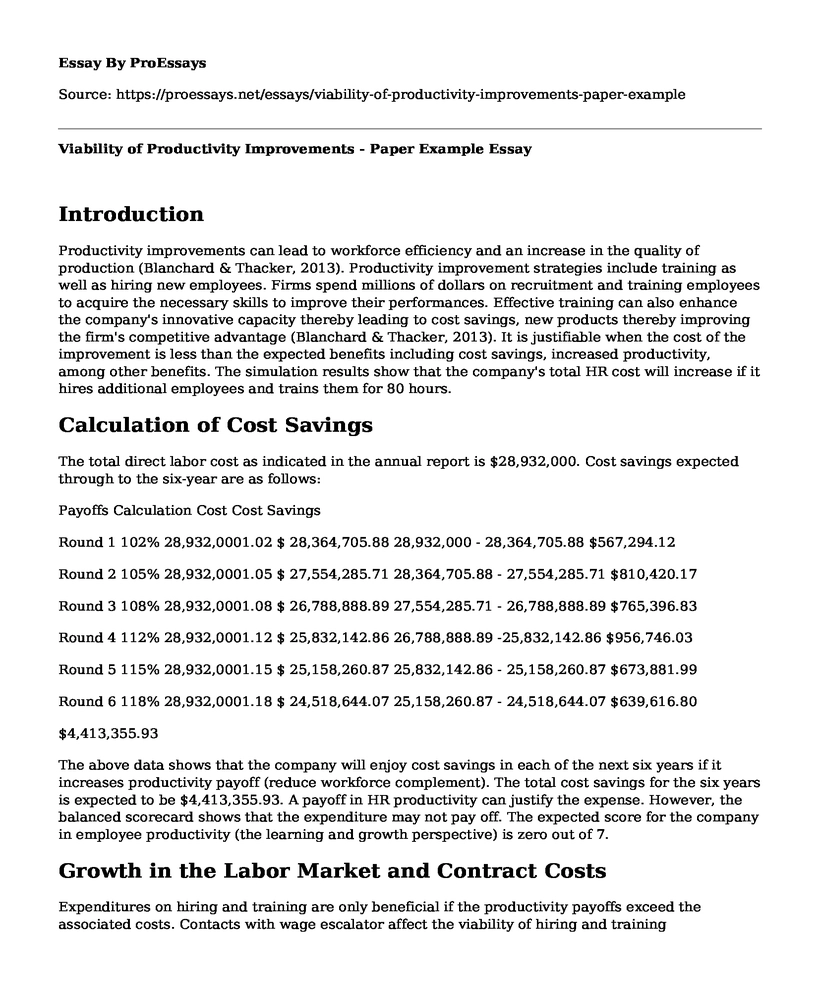Introduction
Productivity improvements can lead to workforce efficiency and an increase in the quality of production (Blanchard & Thacker, 2013). Productivity improvement strategies include training as well as hiring new employees. Firms spend millions of dollars on recruitment and training employees to acquire the necessary skills to improve their performances. Effective training can also enhance the company's innovative capacity thereby leading to cost savings, new products thereby improving the firm's competitive advantage (Blanchard & Thacker, 2013). It is justifiable when the cost of the improvement is less than the expected benefits including cost savings, increased productivity, among other benefits. The simulation results show that the company's total HR cost will increase if it hires additional employees and trains them for 80 hours.
Calculation of Cost Savings
The total direct labor cost as indicated in the annual report is $28,932,000. Cost savings expected through to the six-year are as follows:
Payoffs Calculation Cost Cost Savings
Round 1 102% 28,932,0001.02 $ 28,364,705.88 28,932,000 - 28,364,705.88 $567,294.12
Round 2 105% 28,932,0001.05 $ 27,554,285.71 28,364,705.88 - 27,554,285.71 $810,420.17
Round 3 108% 28,932,0001.08 $ 26,788,888.89 27,554,285.71 - 26,788,888.89 $765,396.83
Round 4 112% 28,932,0001.12 $ 25,832,142.86 26,788,888.89 -25,832,142.86 $956,746.03
Round 5 115% 28,932,0001.15 $ 25,158,260.87 25,832,142.86 - 25,158,260.87 $673,881.99
Round 6 118% 28,932,0001.18 $ 24,518,644.07 25,158,260.87 - 24,518,644.07 $639,616.80
$4,413,355.93
The above data shows that the company will enjoy cost savings in each of the next six years if it increases productivity payoff (reduce workforce complement). The total cost savings for the six years is expected to be $4,413,355.93. A payoff in HR productivity can justify the expense. However, the balanced scorecard shows that the expenditure may not pay off. The expected score for the company in employee productivity (the learning and growth perspective) is zero out of 7.
Growth in the Labor Market and Contract Costs
Expenditures on hiring and training are only beneficial if the productivity payoffs exceed the associated costs. Contacts with wage escalator affect the viability of hiring and training expenditures. Rising labor costs reduce the profit on hiring and training employees (Gibb, 2011). When labor costs are high, the company will employ fewer workers to avoid incurring high labor costs, which reduce the total profit (Mondy & Martocchio, 2016). The company should invest in recruiting and training only up to the level where the costs are just below the productivity payoffs or cost savings expected from the expenditures. In this case, the expected cost savings for the next six years is $4,413,355.93. Thus, the company's recruitment and training budget for the six-year period should not exceed $4,413,355.93.
Non-Financial Considerations
The company should consider several factors beyond the numbers to determine whether it is necessary to invest in recruitment and training. It should consider the effect of the investment on the motivation of the current and new employees (Gibb, 2011). HR practices that lower the motivation of employees to reduces productivity thereby leading to losses. Some of the benefits of a motivated staff are not financial and may not be determined quantitatively. The company should also consider the levels of employee burnout if any. Undesirably high levels of burnout reduce productivity and necessitate investment in recruitment and training (Mondy & Martocchio, 2016). Besides, the firm should consider the legal implications of recruitment and training. It is also essential to take into account the status of the external job market, including the demand and supply of labor.
Conclusions
Investing in recruitment and training can help the company improve productivity and reduce some operating costs. The company is expected to save about $4,413,355.93 over the next six years. Thus, it should invest in recruiting and training employees. However, the efficiency of training and other HR practices should be enhanced to increase productivity. The company should also take into account non-financial factors such as the impact on motivation, legal issues, among other considerations.
References
Blanchard, N., & Thacker, J. (2013). Effective training (5th ed.). Boston, MA: Pearson
Gibb, S. (2011). Human Resource Development. Palgrave Macmillan.
Mondy, R., & Martocchio, J. (2016). Human resource management. Harlow, Essex, England: Pearson.
Cite this page
Viability of Productivity Improvements - Paper Example. (2022, Jul 21). Retrieved from https://proessays.net/essays/viability-of-productivity-improvements-paper-example
If you are the original author of this essay and no longer wish to have it published on the ProEssays website, please click below to request its removal:
- Essay on Intrinsic Motivation in Education Sector
- Total Reward Systems Paper Example
- Essay Example on Casual Employment in Australia
- Essay Sample on Reduce Turnover: Ensure Qualified Employees & Retention
- Research Paper on Job Satisfaction: Factors, Surveys & Findings
- Essay Example on Uniting Diverse Cultures: Integrating Cultural Diversity in HRM
- Lesson Learned: Most Valuable for Future Performance - Paper Sample







